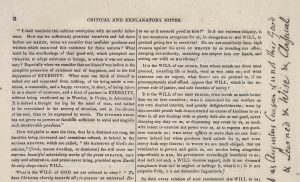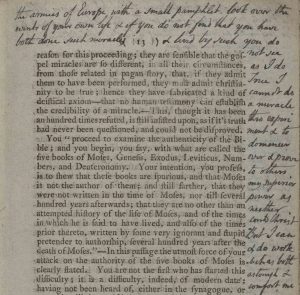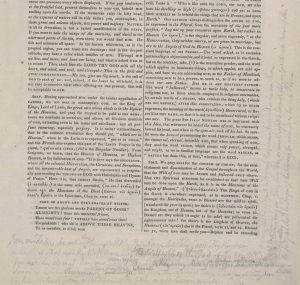Over the last few weeks, I’ve been working piecemeal on encoding Blake’s marginalia for Robert Thornton’s The Lord’s Prayer, Newly Translated (1827), a 10-page pamphlet which gives a new translation of the Lord’s Prayer from the original version in Matthew 6:9-13 and accompanying critical and explanatory notes. Unlike with most of the Blake marginalia pages, which have relatively legible writing —

— deciphering this one was a challenge, and not quite achieved (though I’m hardly alone in failing to do this). The difficulty was largely owing to two features which are not typical of the Blake marginalia in other pages of the Thornton, or in the Watson and Lavater books we’re also working on: it seems to be written in something like smudgy grey pencil, and, at first sight, it seems to consist of one large nebulous mass extending up the right side from the bottom margin. Blake did certainly write his marginal notes all over the margins of his books and sometimes at odd angles to the text on the page:


But not usually both at once. And I don’t think there’s another instance (at least in the books that we have access to) where the marginal writing starts at the bottom of the page and extends sideways up the side of the page. So this seemed odd to me. So I wondered if, instead, we were dealing with two annotations, one in the right margin and one on the bottom margin, which ran into each other in some way that was frustratingly obscured by not only the illegibility of the smudgy grey pencil, but also the multiple erasures, insertions and substitutions evident in the mass.
This is the material in question:

Ignoring (momentarily) the deletions and additions, you can see that there are 5 lines of text on the bottom margin, and 3 or possibly 4 lines on the right margin. The corner of the page shows that these lines run into each other at possibly 2 points, but it is not clear, without a much closer look, how these intersections work. Both of my authorities on Blake’s writing (G.E. Bentley and David Erdman) produce transcriptions of the material as one large mass in the following ways:
Bentley:
Jesus our Father who art in thy Heavens calld by thy Name the Holy Ghost[,] Thy Kingdom on Earth is Not nor thy Will done but [his del] Satans Will who is father & God of this World[,] The Accuser. Let his Judgment be Forgiveness that he may be coverd[?] in his own Shame[?][.]
Give [word del] us This Eternal Day our [Ghostly(?) del.] take away Money or debt or Tax & Value or Price as [. . . Satan del] have all things Common All(?) Things(?) common(?) among us[.] Every thing has as much right to Eternal Life as God who is the Servant of Man[.] The Accusation[,] His Judgment shall be Forgiveness that he may be consumd in his own Shame[.]
Leave us not in Parsimony[?] [word del] Satans Kingdom[;] liberate us from the Natural Man & [word illeg] Kingdom[.] For thine is the Kingdom & the Power & the Glory & not Caesars or Satans[.] Amen
Erdman:
- (Italics within square brackets indicate words or letters deleted or erased or written over. Matter in Roman type within square brackets is supplied by the editor. Angle brackets enclose words or letters written to replace deletions, or as additions)
Jesus our Father who art in <thy> Heaven<s> calld by thy Name the Holy Ghost Thy Kingdom on Earth is Not nor thy Will done but [?Beelzebub] <[his] <Satans> Will who is the God of this World> The Accuser [Let his Judgment be Forgiveness that he may be cons[u]md in his own Shame] <[His Judgment] <His Accusation> shall be Forgiveness [and he shall] <that he may> be consumd in his own Shame>
Give [me] <us> This Eternal Day [my] <our> [Ghostly] <own right> Bread & take away Money or Debt or Tax <a Value or Price> as we have all things common among us Every thing has as much right to Eternal Life as God who is the Servant of Man
Leave us not in [?Poverty ?and ?Want] Parsimony <Satans Kingdom> [but deliver] <liberate> us from the Natural Man & want or Jobs Kingdom
For thine is the Kingdom & the Power & the Glory & not Caesars or Satans Amen.
- (Many illegible erasures, partial restorations, and repetitions probably meant to replace one another have been omitted from this transcript.)
Clearly, neither Erdman nor Bentley have a lot of confidence about figuring out the largely illegible material, which I’ve also given up on to some extent. It is more surprising to me that both of them see the marginalia on this page as one large annotation divided into 3 or 4 distinct sections — it’s not an obvious layout, in my visual experience of the page.
So where did I start? While the writing in the bottom margin was more problematic, the beginning of the lines did appear the clearest.

My choice of transcription for Annotation 1:
(leaving out for the moment choice tags and similar Blake Archive encoding standards; for visual clarity, all additions are in italics, all deletions are crossed out, all illegible material marked with square brackets)
<l>Jesus our Father who art in thy Heavin calld by thy Name this Holy Ghost thy Kingdom</l>
<l>on Earth is Not worthy Well done but his Satans Will who is the father God of the World</l>
<l>Give us This Eternal day our own right [illegible] Bread [illegible] by away Money & Value of Price or Debt or Tax as thy [illegible] have all thy Comon [illegible] Comon among us</l>
<l>Leave us not in [illegible] mon [illegible deleted] [illegible] but liberate us from the Nataral Man [illegible] kingdom</l>
<l>for thine is the kingdom & the Power & the Glory & not Caesars or Satans Amen</l>
Looking carefully at the image, lines 1, 2, 4 and 5 seem to be clearly separate from the mess in the corner and the lines in the right margin; the last words of these lines, ‘Kingdom’, World‘, ‘kingdom’ and ‘Amen’ are distinctly final. Possibly, line 2 does not end with ‘World’ but extends into that slanted line with ‘the Accuser’, but the actual word ‘World‘ itself does not start to curve up the side of the page.
And neither Bentley nor Erdman have argued that the writing in the right margin follows on from each line of the bottom margin writing. Tellingly, they both have different interpretations: Bentley puts half of (what I am calling) Annotation 2 on the end of line 2 of (what I am calling) Annotation 1, and the other half on the end of line 3. Erdman puts most of Annotation 2 at the end of line 2 of Annotation 1 (as if Blake continued one strand of a text at complete right angles to the rest of it) and puts one part of it (a line in the middle) on the end of line 3. So we are to suppose that Blake wrote line 2 at the bottom of the page that extended into the right margin, but left space in the middle for line 3? Neither version makes a whole lot of sense to me.
My version: I agree that line 3 extends into the right margin, to the extent of several illegible words ending in ‘Comon among us’, but that it is the only line to do so. This is obscured a little by the fact that there are supralinear additions to this line in the right margin (‘have all thy Comon’) which make it appear more connected than it actually is. And by the fact that line 3 appears to branch in 3 distinct ways: in the 2 lines that extend into the right margin, and in a 3rd, completely illegible line which continues on into the right corner of the page, itself with a sublinear and also illegible addition at the end.
Other than line 3’s confused wanderings in different directions — are there any visual connections between Annotation 1 and Annotation 2? I don’t think so.
Then there’s the content. Obviously, this would make a lot more sense if I could identify the illegible words and phrases — if anyone else wants to make a go of it, I welcome them to try — but Annotation 1 seems to be a characteristically Blakean paraphrase of the Lord’s Prayer. While Annotation 2 seems to be something different.

My choice of transcription for Annotation 2:
(leaving out for the moment, choice tags and similar Blake Archive encoding standards)
<l>the Accuser Let his Judgment be Forgivess that he may be consmd in his own Shame</l>
<l>Evry thing has as much right to Eternal Life as God who is the Servant of Man</l>
<l>the Accusation</l>
<l>this Judgent shall be Forgivess that he may be consumd in his own Shame</l>
Obviously I am missing out some words here, especially the text immediately before line 2, starting ‘Evry thing has as much right’. (This is where I believe line 3 from Annotation 1 has already butted into the right margin). And the first word of line 1, ‘the’ is noticeably at an angle; it could be argued that it is a continuation of Annotation 1.
But every other aspect suggests that this is something separate. Line 4 (and immediately above it, in what may be an inserted addition, line 3) is clearly at strong right angles to the ends of the lines of Annotation 1. These clearly do not continue the previous writing but start something entirely new. There is a gap before the start of ‘Evry thing’ and the first word is capitalized — allowing, of course, that Blake does capitalize random words, this does also suggest that it is the start of a new sentence. And given where line 1 started, and the overwriting and inserting of new phrases going on in line 3 of Annotation 1, it seems reasonable that line 2 of Annotation 2 would end up being rather close.
Also, thinking about the curved nature of ‘the Accuser’ in line 1, I can offer an explanation which does not involve it being a continuance of Annotation 1. Note how line 3, ‘the Accusation’, is written in a smaller and more cramped hand than the other lines, squashed above ‘this Judgent’, as if it was added in later. Might the same be true of its possible-counterpart, ‘the Accuser’? Which could be said to be in a smaller hand than the ‘Let his Judgment’ which follows, and which may be curved as it is because Blake was trying to fit it into a small space after writing the ‘Let his Judgment’ line first?
I can only say that this is how it appears to me, visually.
All in all, I’m not 100% happy with my version, but I’m not happy with the Bentley and Erdman versions either, and I think there are enough reasons to support my reading. What might solve this problem is a close, better look at the currently-illegible words in the page’s corner. When the marginalia BADs are uploaded to the Blake Archive and made available for public consumption, I highly recommend using the Lightbox feature to zoom in on and crop the marginal writing — you may find something, Bentley, Erdman and I have missed!
